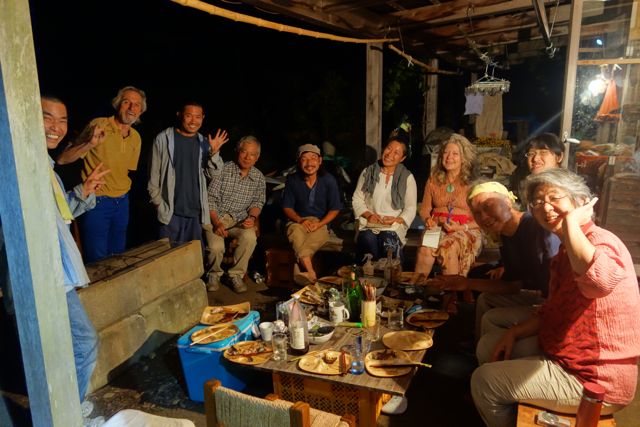Seed Saving in Japan, Taiwan, UK
No activity can be more important than saving seeds of the plants we all need for sustenance - but we have mostly forgotten that art, or science.
People here have not given up on traditional ways of seed saving, according to Imaizumi and Akitsu.
What are the moral codes for seed-saving? From the interviews with practitioners in Japan:
http://link.springer.com/chapter/10.1007/978-981-287-417-7_20#page-1 (pdf)
2015 Food Security and Food Safety for the Twenty-first Century Proceedings of APSAFE2013
http://www.springer.com/us/book/9789812874160
Editors:
http://www.springer.com/us/book/9789812874160
Editors:
ISBN:
978-981-287-416-0 (Print)
978-981-287-417-7
http://seedsavers.net/ has more:
Seedsavers Reunion in Japan
Photo available on facebook page of the seed savers network.
Learn to save seeds: it’s a winner!
Locally adapted high quality seeds are a rare commodity
and cost nothing but patience. Then you avoid spraying pesticides that
are necessary for over-bred, highly-strung varieties of fruits and
vegetables. Moreover, your efforts may become the start of a seed swap
adventure with other gardeners (or in your local seed network), whether
with neighbours, family and friends, in a community gardens or in a
school.
Having met farmers and gardeners in more than forty countries Jude and Michel Fanton, the directors of The Seed Savers’ Network, appreciate that it is gardeners and small land-holders who caretake the food diversity of the world. They are leaving us the living legacy of home-saved seeds that ultimately belong to all of us, and are the responsibility of all of us.
Seed saving peasants, rural and urban gardeners worldwide keep their seed within a friendly active network, and regrow them in their fields and gardens as a living seed bank evolving within culture, and within climate. Institutionalised frozen gene-banks are inaccessible to gardeners and farmers. Increasingly even small seed companies are relying on large corporations for their seed supply.
To remain independent of Big Seed, an increasing number of gardeners and peasant farmers, urban gardeners, small rural landholders are saving their own and gifting and exchanging their seeds with other who also do. No amount of rethoric will change anything. However educating ourselves with other seedsavers in Local Seed Networks do.
In the News
Southern Taiwan forestry expert mulls seed museum
 Southern
Taiwan forestry expert Chang Wen-ting displays her extensive seed
collection at a recent educational event held by Pingtung Forest
District Office. (UDN)
Southern
Taiwan forestry expert Chang Wen-ting displays her extensive seed
collection at a recent educational event held by Pingtung Forest
District Office. (UDN)- Publication Date:07/13/2015
- Source: Taiwan Today
Chang Wen-ting, a technical specialist with Pingtung Forest District Office at the Council of Agriculture’s Forestry Bureau, is known by the nickname Sister Seed for her extensive field knowledge and 1,000 samples collected since 1997.
Discovering a passion for seeds when a forestry student at National Pingtung University of Science and Technology, Chang said she credits a chance encounter with the seed of Cassia grandis, or pink shower tree, for the lifelong pastime.
From the UK:
Some useful references
"Back Garden Seedsaving" by Sue Stickland (ISBN 1899233091) is an excellent reference with a good intro to seedsaving plus details about each individual crop.
"Seed to Seed" by Suzanne Ashworth.(ISBN 1882424581) tells you simply and clearly what you need to do to save seed of any veg you care to mention using materials you have at home.
"The Seed Savers Handbook" Jeremy Cherfas, (Grover Books, 1996) is also good and also talks in more detail about the reasons that you might want to save your own seeds.
"Breed your own Vegetable Varieties" by Carol Deppe ( Chelsea Green Pub Co; ISBN: 1890132721) is a good introduction to vegetable breeding for the interested amateur. Until 50 years ago, all gardeners were plant breeders - it's not difficult, you just need to know how to do it, and the tradition has been lost. This book will give you the basics, and then if you're interested, the nitty-gritty too.
 The Real Seed Catalogue has this advice:
The Real Seed Catalogue has this advice:
Seed-saving is easy. You'll get better seed than you can
buy, even from us. And you can keep your own varieties going for future
years. But .. . just as with growing the plants, there are a few key
bits of information you need to know to keep varieties pure. It's not
hard, you just need to know how to do it. One key thing before you start - you can't save seed from F1 (hybrid) varieties. You need real, open-pollinated seed, like ours. We don't have any hybrid seed at all, for this very reason.
Later, do remember to dry your seed properly, or
it will not survive storage. Don't use heat though to dry it - we have a
whole info sheet on drying your seed, so read that when you've got it harvested. For now all you need to do is start with
non-hybrid seed, & read on to find out how many plants you need to
grow, and what to bear in mind to get good seed that is true to type.


Comments